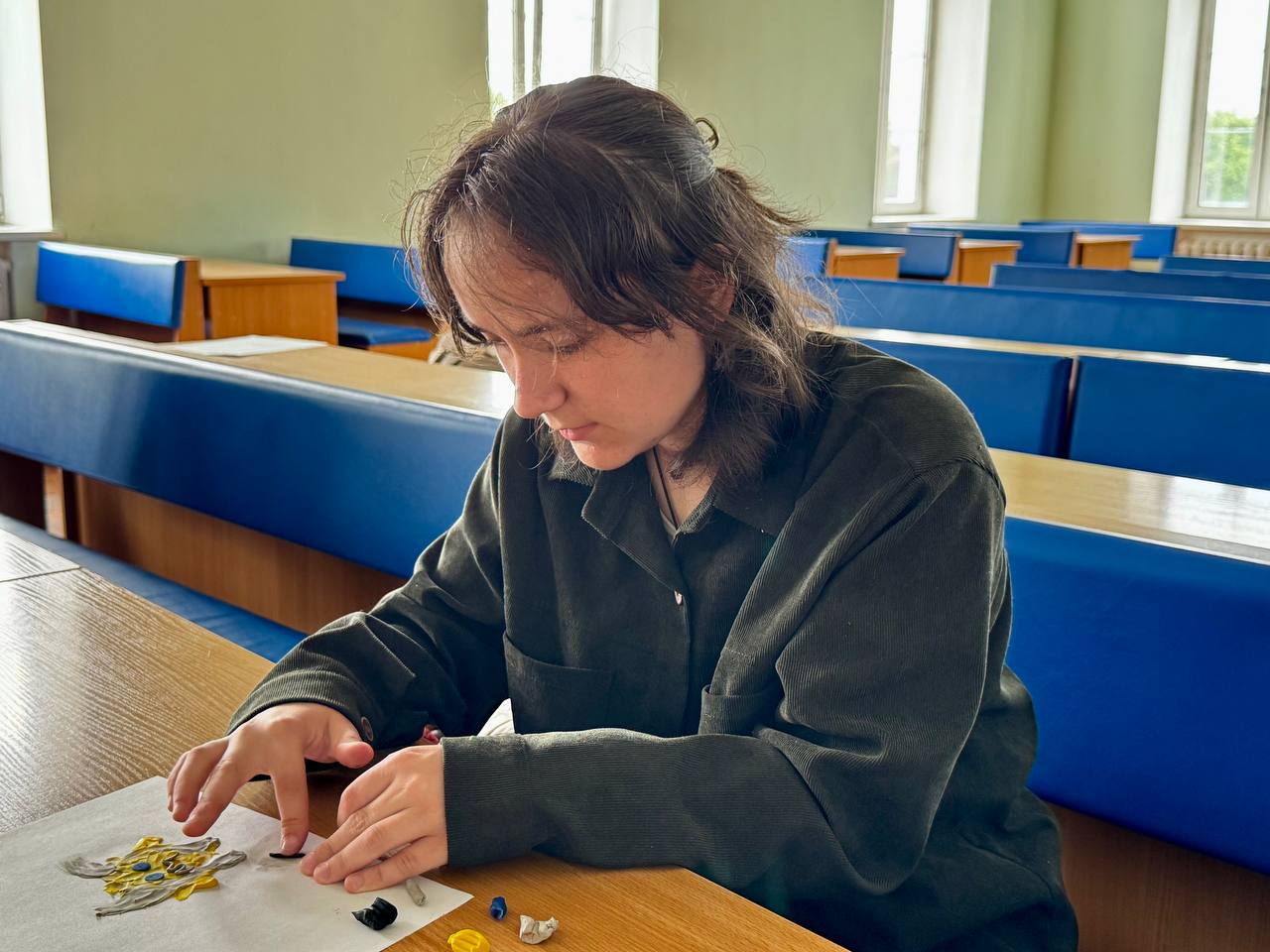A critical art therapy session titled “My Inner Fear” was recently held at Poltava Polytechnic. It was facilitated by faculty members from the Department of Psychology and Pedagogy, PhD in Psychology, Associate Professor Viktoriia Shevchuk; PhD in Pedagogy, Associate Professor Maryna Teslenko; and PhD in Pedagogy, Associate Professor and Acting Head of the Department, Lesia Klevaka. The session was specially adapted for students who are internally displaced persons (IDPs) and aimed to help them transform the destructive emotion of fear into an internal resource that supports personal growth and psychological resilience.
The core psychological idea of the event was to raise awareness, acceptance, and “transformation” of fear through creative self-expression. In the context of traumatic experience and forced migration, fear often becomes overwhelming and paralyzing. Art therapy provides a safe, non-verbal space for exploring complex emotions, bypassing conscious resistance and the psyche’s defence mechanisms.
During the session, participants engaged in the following stages:
• Visualisation of fear (modelling with clay). This is the first and key step in working with intense emotions. By externalizing fear from the inner world and giving it a physical form (a clay figure), participants make it less abstract and therefore less omnipotent and more manageable. The symbolic embodiment of fear allows for distancing and an external perspective. Clay, as a flexible material, enables the free expression of the most hidden aspects of fear. The ability to physically manipulate the image of fear (squeezing, stretching, reshaping) fosters a sense of control over it — a crucial element for people who have experienced real-life loss of control.
• Understanding fear (describing the image). After creating the physical form, describing its appearance, “desires,” and symbolic meaning is a stage of integrating the non-verbal experience into the cognitive domain. This encourages deeper emotional awareness, allowing participants to name, comprehend, and accept aspects of fear that may have previously been suppressed or unrecognized.
• Transformation of the image. Changing the colours, shape of the fear figure, or integrating it with resourceful elements represents a powerful therapeutic act. On a symbolic level, participants actively “rewrite” their relationship with fear. This is more than a visual change – it’s internal work that helps turn a negative experience into a source of strength. The colours and shapes chosen for transformation reflect internal shifts and new cognitive attitudes.
• Creation of a resource image (“My Protector” or “My Resource”). The final stage focuses on positive reinforcement. Creating an image of a “protector” or “resource” is an act of constructing an inner psychological foundation. It is a visualization of personal strengths, qualities, and external sources of support that help overcome difficulties. This drawing becomes an “anchor” that participants can return to in the future to activate feelings of safety, strength, and control.
During the event, the following art therapy exercises were used:
• “My Fear – My Helper”. This exercise promotes cognitive reframing. Instead of seeing fear as an enemy, participants learn to recognise its adaptive function (e.g., as a signal of danger that prompts action, or as an indicator of what we value and wish to protect). This reduces its paralyzing effect.
• “Safety Map”: Helps participants identify and visualize internal and external sources of safety. These may include a real place, a person, a memory, or an internal quality. Creating such a map fosters a sense of grounding and stability in a changing world.
• “Shield of Strength”. An exercise in building internal protection. Visualising a shield decorated with symbols of personal qualities and resources enhances the sense of one’s ability to face challenges and protect oneself.
• “Dialogue with the Image of Fear”. This technique allows for direct interaction with the externalized fear: participants ask it questions, express their feelings, and even negotiate with it. This gives them an active role rather than the passive one of being a victim of their emotions.
• “Web of Support”. A group exercise aimed at fostering a sense of community and connection. Creating a symbolic network from threads, where each participant shares words of encouragement, significantly reduces the feeling of isolation, a common issue for IDPs. The activity fosters empathy and a sense of belonging, which is a powerful buffer against stress.
As a result of this art therapy session, participants experienced reduced emotional tension, a new attitude toward fear, an enhanced sense of control and internal support, as well as the development of emotional intelligence and imagination.



















This session marked another meaningful step in the implementation of the Erasmus+ KA220-ADU TRUST project – Trauma of refugees in Europe: An approach through art therapy as a solidarity program for Ukraine war victims (Grant No. 2024-BE01-KA220-ADU-000257527). The project is co-funded by the EU and led by the Centre Neuro Psychiatrique St-Martin from Belgium, in partnership with the National University «Yuri Kondratyuk Poltava Polytechnic» (Ukraine), Greek Carers Network EPIONI (Greece), Fondazione Don Luigi Di Liegro (Italy), Lekama Foundation (Luxembourg), EuroPlural Project (Portugal).
Additionally, Poltava Polytechnic is currently conducting a series of art therapy sessions as part of the TRUST project. These sessions have included symbolic activities such as designing personal coats of arms to represent inner values, sources of strength and hope; associative drawing exercises; the “Relationships” activity aimed at reflecting on personal connections with loved ones, community, and country; discussions around “What does mental health mean to me?”; neurographic drawing; and immersion in body-oriented therapy where movement, dance, and physical expression become key tools for emotional release and recovery.
Media Centre of
National University “Yuri Kondratyuk Poltava Polytechnic”



